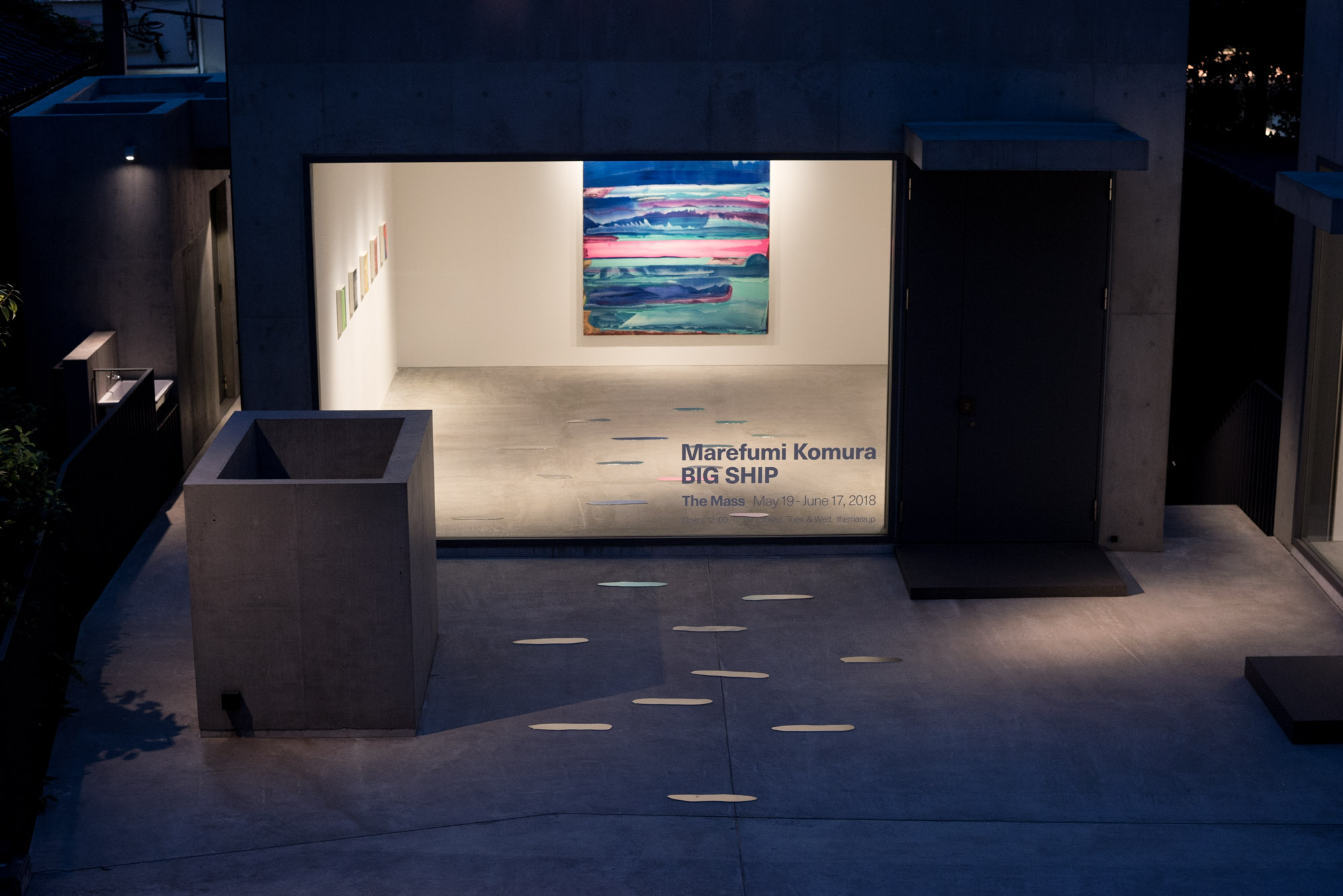Marefumi Komura, a painter who loves imperfection

Are you familiar with the painter Marefumi Komura? He is known for his bold brushstroke portraits, but his solo exhibition “Big Ship” being held at Harajuku gallery The Mass showcased a new series of abstract paintings that have opened up new ground. Customers deeply immersed in the arts make their way to the reception, and during the day paintings were so popular that more than half of them found buyers. We get up close and personal with Marefumi Komura, a painter who believes in the “beauty that lives in imperfection”.
Photo, Shoichi Kajino | Edit & Text, Mio Koumura
– Your hometown is Osaka, or is it Tokyo? The two come up when searching.
I am from Tokyo. I wrote that I was from Osaka because I heard that I grew up in Osaka when I was small but later found out that I was from Tokyo. I grew up hearing I was blood type ‘A’, but at the very beginning of the year last year my mother said, “you’re type O” (lol)
– Your parents sound interesting. What inspired you to be a painter?
I liked rock music from abroad and experimental music and was always playing when I was in high school, but when I went to Seattle after graduating, I could not speak English directly and didn’t have the courage to form a band. I began to immerse myself in painting which I liked since I was small. At that time I wasn’t thinking that I would go on to become a painter.
– You’re self taught?
Almost. I like painting when I was a student and although I went to drawing class in the US, that doesn’t mean I went to art school or studied a foundation programme or the history of painting.

– So you started painting as soon as you returned home?
When I returned to Japan I decided to “live by painting”, but became a full time employee since I knew I needed money to make work. I was really busy everyday making presentations and instruction manuals with design planning work, but t was hard, having no free time except for when I went home to eat.
– Were you making things in between?
When I was able to do it on the weekend it was quite difficult, so was sketching every day on the train to work. I have a small sketchbook and stand at the edge of the train everyday. That way, you can see everything. From there I draw the people I can see one by one. I was riding for about an hour, so drew roughly ten people in a day.
– Everyday in-between work?
That’s right. But don’t think I can do it now if I say I do (lol). For someone working full time you get paid every month so it’s natural, right? I was getting used to that life somehow and felt that little by little my thoughts toward painting would fade away. I think that I wanted to continuing drawing a line in order for me to stave off the feeling that such a thing was “impossible”.
– You established a style by continuing to sketch portraits?
Now I think of it, it might have been the starting point. Every day the same people ride in the same train. Inevitably I will draw the same person many times over, but when surveying a person’s face I would see that person’s mannerism, and guess I never got bored with the different discoveries there.

– What was the turning point, graduating from office worker to painter?
Taking part in the contemporary art festival “GEISAI” in 2006 was big. I was given a booth as a presentation space and exhibited an oil portrait painting. At that time, I received an award from Hiroshi Fujiwara.
– The portrait image is strong, but this time the exhibition ‘Big Ship’ is filled with abstract paintings.
The portrait is important to me, but it is not a body of work that represents ‘Marefumi Komura’ as a painter, and I’ve always painted abstract paintings at the same time. I even put in one or two of abstract portraits in the solo exhibition at that time. The Mass had once showed me the space during construction and from that moment on wanted a solo exhibition there. When it was realised, it just overlapped with being able to show my own ‘Subtract’ abstract series.
– The painting ‘Subtract’ is completed by subtracting and scrapping off.
I don’t like complete things that much and there is a tendency to want to leave as much roughness as possible. The overlaying of paint in Western oil painting is basic, and the appeal is the strength, the three-dimensionality, and fleshiness can be felt, but ‘Subtract’ is the reverse. Removing the first layer of paint with a spatula or an eraser creates an unexpected gradation. Theres a fragility and beauty to the imperfections, and feel there’s something the gracefulness of the work has in common with Japanese people.

– What kind of thing is the Japanese characteristic of ‘elegance’?
The concept of graceful feeling seems deeply rooted in Japanese people. From long ago, Japan was a country with many disasters. When a major earthquake took place overseas the reports exaggerated that “Japanese people were not concerned, so it was nothing”, but I think that look of not being in the slightest bit concerned is the aspect of strength and beauty possessed by Japanese people. One you’ve started scrapping you can’t start over. The look created from improvisation and the unexpected makes works far more vibrant.
– How does one analyse Kimura’s works that lead to portraiture and ‘Subtract’?
Although it’s often said I don’t understand my paintings, I thought that is something the viewer should decide. I want to leave what this picture looks like up to the viewer, and want to make it ambiguous even within me. Looking at something like picking up pieces is important, and I think that imperfection is a lot like my work.
– What was the thinking behind the title, ‘Big Ship’?
When I decided to do an exhibition and visited The Mass a few times, the exhibition space along Cat Street and the small glazed structure on top looks like a ship. It is abstract painting only exhibition, and perfect because I thought an abstract title would be good. Later on, I noticed it also overlaps music on Brian Eno’s album “The Big Ship”, who is also my favorite artist, so decided to make sound based on that and thought we’d let it flow through venue.
– It’s unusual for music to flow through a painting exhibition.
Treating the venue as a ship, the first floor contacting the surface of the water stretches sound until the rhythm of the drum sounds like a rippling sound, and conversely, the second floor raises the pitch to treble, pointing toward the sky and looking up to the universe, mixing the sound until all that remains is the Jupiter Whistle sound heard when approaching Jupiter. Not only the music of the venue, but I have also been making books several in the past, but my work is cut in half and a bit different this time is from a more general collection of works. I like explaining what things are so really appreciate you listening to me talk about myself so much this time.
– You call yourself ‘painter’, not artist.
Paintings are alive and special somehow, and in a sense deviate away from society. ‘Artist’ means so many different things these days and it feels easy to have connect with society somehow. There’s no friction, but I feel different myself somehow.
– What’s the appeal of a painter?
The painter appeal isn’t that big. But, it’s funny because I think paintings aren’t necessary on a daily basis. For example, fashion is just as essential to life as food, clothing, and shelter, and design is something we need because it is also more useful and necessary. So its precisely because of this I believe that painting isn’t necessary day in day out. I don’t want a world for instance, where there is nothing to not want for.

Marefumi Komura, ‘Big Ship’
May 19 – June 17, 2018
at The Mass, 5-11-1 Jingumae, Shibuya-ku Tokyo
Open: 12:00–19:00
Closed Tuesday, Wednesday
Free admission
- Keywords:
- Drawings


